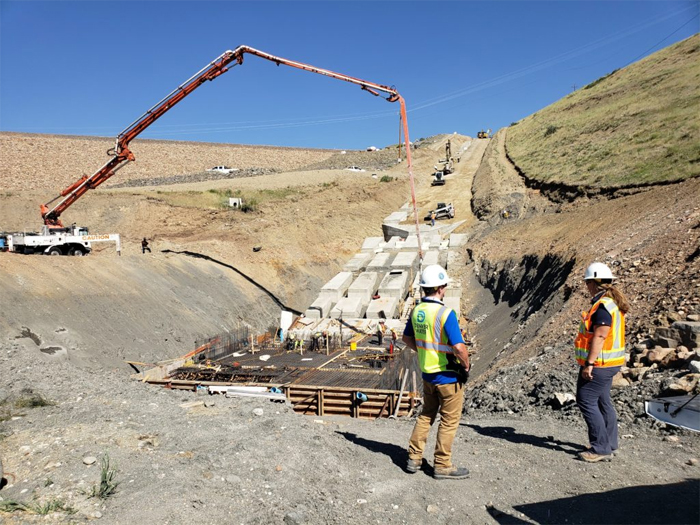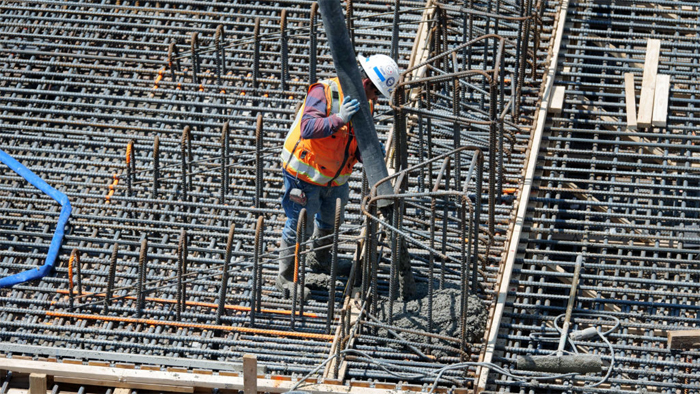Building A New Spillway In The Name Of Safety
Denver Water launches $8.5 million investment at 1930s dam north of Golden.
On a hot summer day off Highway 93 north of Golden, 19 concrete trucks trundled like big beetles up to the base of Ralston Dam, completed in 1936.
At the base of the dam, workers placed the concrete into forms laced with reinforcing steel rods, better known as rebar, one of the many upgrades that are part of an $8.5 million project to replace the dam’s original primary spillway with a new one that meets today’s engineering standards.
“We did a comprehensive review of the spillway and found that it presented a risk because it wasn’t up to current standards, so we needed to replace it,” said Erin Gleason, the design project manager on the project and a dam safety engineer at Denver Water.

On a summer day, 19 trucks brought 190 cubic yards of concrete to help build a new spillway for the Ralston Dam, completed in the 1930s. (Photo credit: Denver Water)
Work at the site started in 2019 and on this summer 2020 day, the workers would place about 190 cubic yards of concrete for the new spillway, a ribbon of concrete some 1,000 feet long that runs down steep slope, 33 degrees at the steepest point.
The project is expected to be complete in early 2021.
Spillways are a safety feature on dams.
Much like a diversion drain in a sink or bathtub, the spillway on a dam diverts water before it can flow over the top of the dam — potentially damaging the dam and whatever lies below the dam.
“All Denver Water dams have spillways, they’re a safety feature,” Gleason said. “If a big storm passes through, the water has a safe place to go and doesn’t go over the top of the dam.”

Eric Swanson, left, a construction manager at Denver Water, and Erin Gleason, a Denver Water dam safety engineer and design project manager for the Ralston spillway project, discuss the day’s progress on the new spillway for the Ralston Dam. (Photo credit: Denver Water)
Denver Water routinely performs assessments of its dams, spillways and other infrastructure to ensure they’re safe and operating correctly.
A record rainfall in February 2017 damaged the primary and emergency spillway on the Oroville Dam in Northern California, forcing more than 180,000 people to evacuate.
That incident reinforced the need for the spillway assessments that were already underway at Denver Water.
Colorado also has experienced intense rainstorms, and more are expected as weather patterns become more variable due to climate change.
In September 2013, several days of rain fell in the Front Range foothills. The floods that followed killed 10 and caused nearly $4 billion in damage across 24 counties.

Following days of rain, water went over Ralston Dam’s emergency spillway on Sept. 10, 2013, one of the few times the emergency spillways has been used since the dam was built. (Photo credit: Denver Water)
In Jefferson County, nearly 15 inches of rain fell over five days and Ralston Reservoir quickly filled to capacity, sending water rushing down the primary spillway built in the 1930s. On Sept. 10, 2013, water from the storm filled Ralston’s primary spillway and poured down its emergency spillway.
Ralston’s emergency spillway is an earthen channel on the north side of the dam. It experienced some erosion due to the rushing water and was later reinforced with rock. The 2013 storms didn’t damage Ralston’s primary spillway.
But the 2013 incident, combined with the thorough review that Ralston received after the Oroville Dam incident, put Ralston’s primary spillway on Denver Water’s list for replacement, Gleason said.

The concrete in the new spillway is reinforced with steel bars, known as rebar. (Photo credit: Denver Water)
“It had incredibly good quality concrete, but the design of the spillway wasn’t up to today’s standards,” Gleason said.
The spillway’s sits on soft shale, which is weak by nature and can shift and erode. The original spillway didn’t have a system of drains underneath the concrete to move seeping water away from the spillway. It also didn’t have reinforcing in place to prevent individual slabs from lifting away from the rest of the spillway.
“One of the main pieces of this project is to make sure we’re founding the spillway on good, solid bedrock. The foundation is always the most critical part of a project,” Gleason said. “We’ve excavated at least 9 feet down in some areas to get to the bedrock.”

Workers smoothing new concrete into place at the new spillway at Ralston Dam. The original spillway was completed with the dam in the 1930s. (Photo credit: Denver Water)
In addition to sitting on solid bedrock, the new concrete slabs are thicker than the old slabs. And they’ll be anchored some 15 to 21 feet into the bedrock with rebar, reducing their potential to shift over time due to weather events.
“At Denver Water, we really focus on dam safety and take it seriously,” Gleason said. “That’s evident by this project and our continual assessment of the safety of all our dams.”

Pouring concrete for the new spillway at Ralston Dam, replacing the original one built in the 1930s. (Photo credit: Denver Water)
